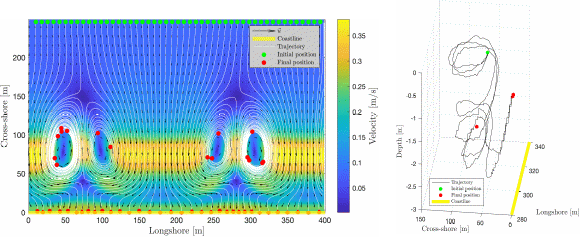E. Zygarłowska1*, H.E. de Swart1, A. Nnafie1
1 Institute for Marine and Atmospheric research Utrecht, Utrecht University
*corresponding author:
Introduction
In this study, the motion of particles in the nearshore zone of single-barred beaches is investigated. Spreading and accumulation of particles in the coastal areas are very relevant to study, e.g. in the context of waste management and maintaining clean beaches. Particularly important drivers of particle motion include rip currents, the Stokes drift, wind-driven currents, currents driven by wave rollers, the undertow, and turbulence (van Sebille et al., 2020). Here, the motion of both passive buoyant and non-buoyant particles under different environmental conditions is analysed. Focus is on whether, and under what conditions do the particles beach, get trapped close to the shore, or escape into the open ocean.
Methods
As a case study, the motion of plastics in a single-barred beach system in Duck, North Carolina, is analysed. To track the particles both on the surface of the water, but also within the water column, a 3D wave-averaged model was developed. The Lagrangian velocity field used for the computations was derived from the output of a nonlinear morphodynamic nearshore model (Garnier et al., 2008). Several simulations with varying wave conditions and wind patterns were performed to quantify the relative importance of the drivers on the motion of both floating and sinking plastics released at different locations of the model domain. Moreover, the probability distribution of the particles' fate, i.e. whether they beach, get trapped or escape, and the associated time scales were computed.
Results
The relative importance of different drivers depends on the initial environmental conditions. For floating particles (Fig. 1 left), weak rip circulation favours onshore movement of the particles due to combined effects of the Stokes drift and wave rollers. However, if the particles sink (Fig. 2 right), the undertow moves them away from the coastline where they can get trapped in the rip cells. The turbulence affects the trajectories of the particles widening the probability distribution of their final position.

Figure 1: Left: Lagrangian flow field in the nearshore zone of Duck and the resulting trajectories of floating particles released at the offshore boundary without the effect of turbulence. Right: Trajectories of 3 sinking particles released close to a rip cell with added turbulence.
References
Garnier, R., Calvete, D., Falques, A., Caballeria, M. (2006). Modelling the formation and the long-term behavior of rip channel systems from the deformation of a longshore bar. Journal of Geophysical Research. 113, C07053. doi:10.1029/2007JC004632
Van Sebille, E., Aliani, S., Law, K., L., et al. (2020). The physical oceanography of the transport of floating marine debris. Environmental Research Letters. 15(2). doi:10.1088/1748-9326/ab6d7d
I. Surname1*, F.N. Another-Surname2 , Y. Next-Surname2
1 University Name, Country; 2 Organization Name, Country
* Corresponding author: mail.name@organization.org


